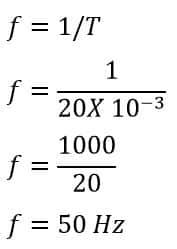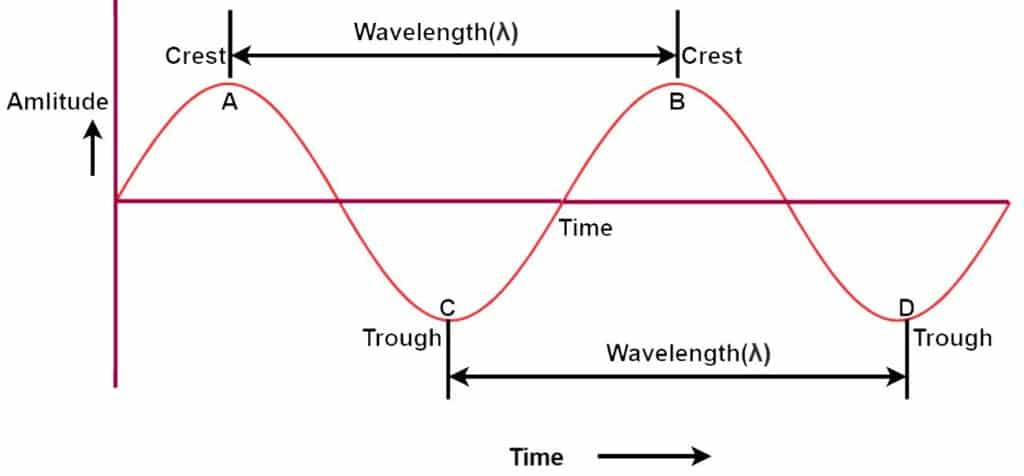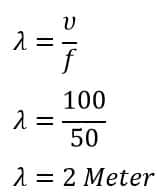The significant difference between frequency and wavelength is that frequency shows the number of wave oscillations in a given time frame. Whereas, the wavelength shows the distance between any two successive crests and troughs of a wave. Thus, frequency and wavelength both are important parameters of a waveform.
Comparison Chart( Frequency Vs Wavelength)
| Basis for Comparison | Frequency | Wavelength |
|---|---|---|
| Basic | The number of wave cycles completed per second is known as frequency. | Wavelength is the distance between two successive crests or troughs of a wave. |
| Measures in | Time | Distance |
| Denoted by letter | f | λ |
| Measuring Unit | Hertz(Hz) | Meter |
| Formula | f = v / λ, where v is the speed of a wave | λ = v / f, where v is the speed of a wave |
| Range- Audible & Visible | The audible frequency range is between 20 Hz to 20 kHz. | The wavelength of visible light ranges from 400 nm to 700 nm. |
Definition of Frequency
A wave does vibrations or oscillations in a unit of time. A wave starts from point A, attains amplitude B, goes to C and then D, and finally comes at its initial point A. Thus, a wave completes one cycle. If a wave takes one second to complete this one cycle, then the frequency of a wave is 1 Cycles/s (C/s)or 1 Hz. If the wave completes 10 oscillations in 1 second, then its frequency is 10 C/s or 10 Hz.
The more oscillations show that a wave has a higher frequency.

From the above figure, it is very clear that the frequency increase with an increase in oscillation in a wave. If the frequency is 20 kHz, it means the wave completes 20,000 oscillations in one second.
The wave frequency can have values in the larger range, such as kHz, MHz, or GHz. We denote the frequency by a letter ‘f’ or ‘ν’. The duration of completion of one complete oscillation is called a time period.
Frequency shows the vibratory or oscillatory motion of any waveform, such as sound wave, light wave, microwave, electromagnetic wave, infrared wave, mechanical vibrations, etc. There exist a relationship between the frequency and time period. The frequency of a wave is inversely proportional to the time period.

For example, if a time period of a wave is 20 milliseconds, then the frequency of the wave will be 50 Hz.

The time period tells the duration of the repetition of a wave. If the time period of a wave is 20 milliseconds and it shows that a wave completes its one cycle in 20 milliseconds and then the wave repeats.
Definition of Wavelength
The distance between two consecutive crests or troughs is called wavelength. The crest point is the highest point of the wave whereas the trough is the lowest point.

The wavelength is measured in the units of distance, such as meters, centimeters, millimeters, nanometers, etc. The wavelength is measured in the direction of motion of the wave, and it is denoted as ‘λ’(lambda).
A smaller wavelength of the sound wave has a higher frequency and produces higher tones. A larger wavelength sound wave has low frequency and produces lower pitch sounds. Thus the smaller wavelength sound waves reach the listener faster than a higher wavelength wave.
The wavelength formula or the wavelength equation is given below.

Example: If the speed of a wave is 1000 meters per second and the frequency of the waves is 50 cycles per second, what is its wavelength?

Wavelength is inversely proportional to frequency. Therefore, the longer wavelength has a lower frequency. Similarly, a shorter wavelength has a higher frequency.
The different colors have dissimilar wavelengths. The wavelength of the red color is the longest, whereas the violet color has the least wavelength.
Key Differences between Frequency and Wavelength
- Frequency is the total number of oscillations or vibrations in a unit of time. Whereas, the wavelength is the distance between two consecutive crests or troughs points of the wave.
- Frequency shows the time of the wave. While wavelength measures the distance.
- The unit of frequency is cycles/second or Hertz. The measurement unit of wavelength is meter.
- Frequency is the ratio of speed and wavelength. Whereas, the wavelength is the ratio of speed and frequency.
- The range of audible frequency is 20 to 20 kHz. The range of wavelength of visible light is 400 to 700 nm.